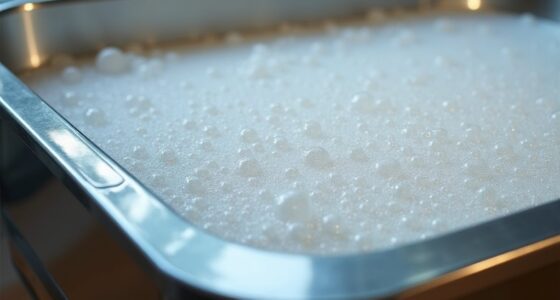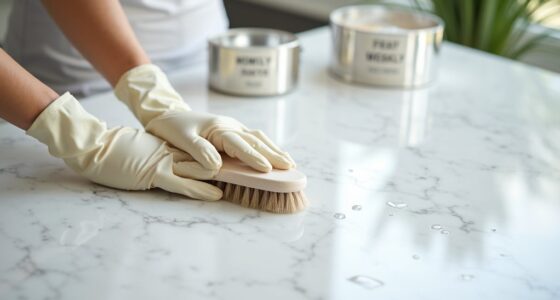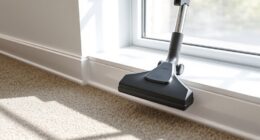To maintain your floor scrubber like a pro, start with daily checks of pads and brushes, ensuring they're clean and not worn. Inspect hoses for cracks and keep your tanks drained and rinsed. Weekly, monitor battery levels and charge them fully after use. Also, assess for leaks and lubricate moving parts monthly. Choosing the right biodegradable chemicals is crucial, too. Stay tuned to discover more tips and best practices for keeping your equipment in top shape.
Key Takeaways
- Regularly wash pads and brushes after each use to prevent dirt accumulation and ensure optimal cleaning performance.
- Inspect and replace worn pads, brushes, and hoses to maintain effective operation and prevent damage.
- Drain and rinse solution and recovery tanks daily to avoid residue buildup and maintain hygiene.
- Check battery water levels weekly and charge fully after each use to prolong battery life and performance.
- Conduct monthly assessments to identify leaks, tighten fasteners, and lubricate pivot points for smooth operation.
Daily Maintenance Essentials
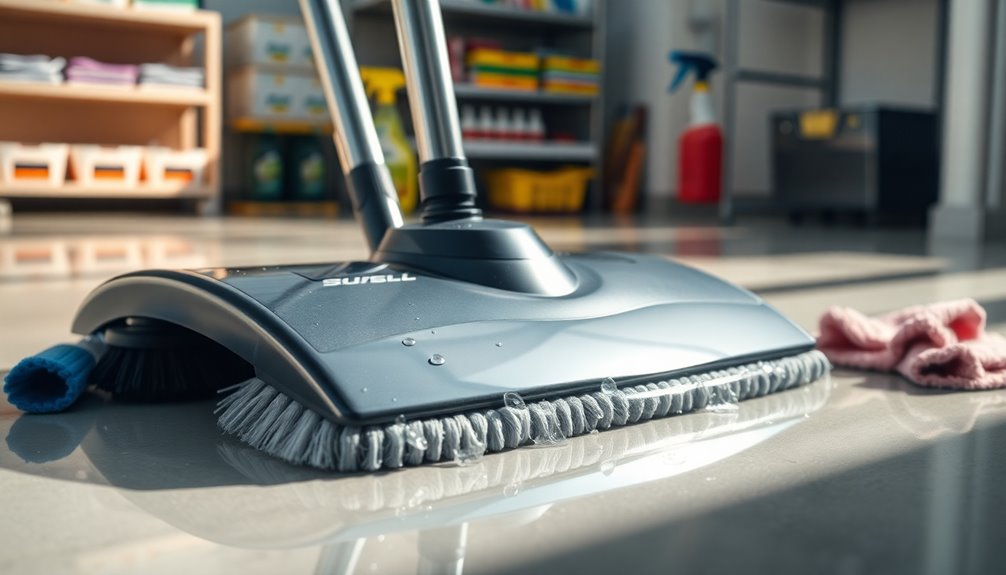
To keep your floor scrubber in top shape, daily maintenance is crucial. Start by washing pads or brushes after each use to eliminate dirt and debris. Inspect them for wear and replace any that are damaged. Additionally, make sure to check hoses for cracks or leaks to ensure optimal performance.
Don't forget to raise the squeegee and wipe down the blades to prevent streaks. After using the scrubber, drain and rinse both the solution and recovery tanks to avoid residue buildup. A damp wipe of the entire machine with an approved cleaning solution keeps it hygienic. Also, check hoses, lids, and gaskets for cracks or leaks.
When storing, keep the machine upright, ensure the tanks are dry, and recharge the batteries if needed. Following these steps ensures long-lasting performance.
Weekly Battery Care Tips

While you might think daily maintenance is enough, paying attention to your floor scrubber's battery each week is essential for optimal performance.
Start by checking the water level in wet flooded batteries, ensuring it's adequate. For gel and AGM batteries, follow the manufacturer's specific maintenance guidelines. Regular inspections and cleaning prevent ineffective water pickup to ensure your scrubber runs efficiently.
Always charge your batteries fully after each use, but avoid overcharging to prevent damage. Store them in a cool, dry place and check for any signs of wear or corrosion on terminals and connections.
Make sure all connections are tight to prevent power loss. Lastly, ensure your batteries are fully charged before use and monitor energy consumption to maximize their lifespan.
Regular attention ensures your scrubber runs efficiently.
Monthly Equipment Assessments
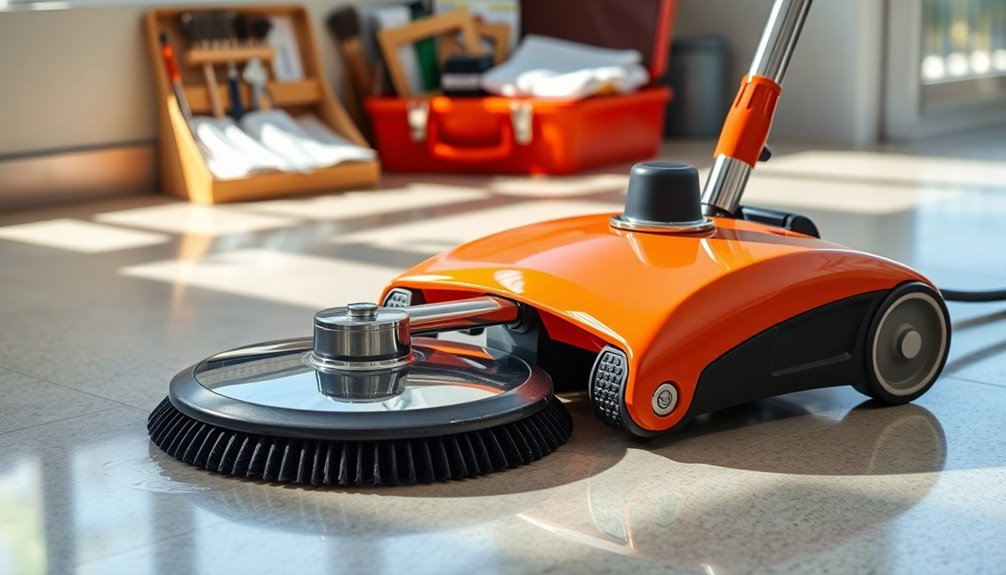
Monthly equipment assessments are crucial for keeping your floor scrubber in top shape and ensuring it operates efficiently.
Start by inspecting for leaks in the solution and recovery tanks, checking hoses, lids, and gaskets for any cracks. Tighten loose fasteners and replace any damaged parts immediately to prevent further issues.
Next, lubricate all pivot points using machine-safe lubricant; this reduces wear and maintains smooth operation. Regularly replacing worn-out pads is also essential for effective cleaning performance.
Don't forget to flush the system by running hot water and alkaline detergent through the machine. After letting it sit overnight, rinse the tank with clean water.
Finally, perform a full assessment to spot any signs of wear, addressing issues promptly to extend your scrubber's lifespan. Regular maintenance is key!
Choosing the Right Chemicals

Regular maintenance of your floor scrubber goes hand in hand with selecting the right chemicals for cleaning.
First, consider your floor type; using incompatible chemicals can cause damage. Opt for biodegradable and environmentally friendly options to support sustainability. Additionally, using TennantTrue detergents ensures optimal cleaning results for various floor types. Home Security Systems often require careful selection of compatible products to ensure safety.
Different floors require specific solutions—degreasers work best on oily surfaces. Always follow the manufacturer's guidelines for chemical usage to protect your equipment.
Low-foam detergents are ideal, as they prevent clogging and damage to the scrubber's components. Additionally, ensure the chemicals you choose are compatible with your scrubber model and look for NSF-approved products for safety.
Proper Pad and Brush Maintenance
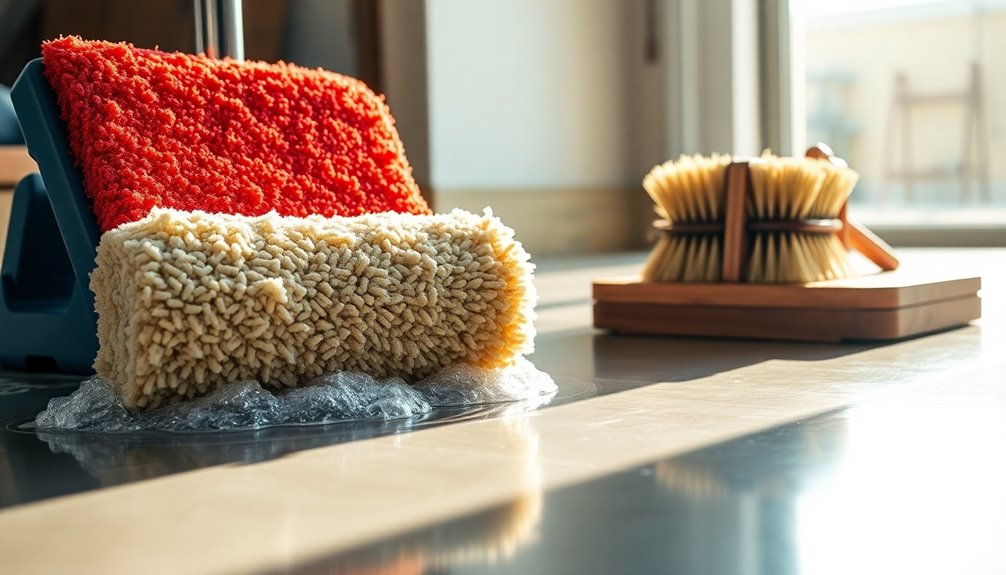
To keep your floor scrubber performing at its best, proper pad and brush maintenance is essential. Clean pads with hot water and a garden nozzle, then hang them to dry to prevent moisture buildup. Remember to use both sides of the pads to extend their life. Replace pads when they lose about 50% of their weight or thickness. Regular maintenance extends the life of pads and brushes.
For brushes, clean them similarly after each use and rotate them weekly to ensure even wear. Lay or hang brushes to dry, and replace them when bristles fray or shorten. Regularly inspect pads and brushes for signs of wear, and remove any debris that could impact performance. These practices will keep your equipment in top shape and enhance its cleaning efficiency.
Troubleshooting Common Floor Scrubber Issues

Effective maintenance of pads and brushes sets the stage for troubleshooting common floor scrubber issues.
If you're facing ineffective water pickup, check for damaged squeegees, ensure your recovery tank isn't full, and look for blockages in hoses or filters. A proper squeegee rubber type enhances water pickup. Regularly clean and maintain components to prevent future blockages.
For poor cleaning results, ensure your brushes or pads aren't worn and use the right chemicals for the surface. Adjust brush pressure levels for better efficiency.
Water dispersion issues may stem from blockages in the solution filter or solenoid, so keep these components clean.
Lastly, if you experience power or runtime issues, ensure batteries are fully charged and connections are secure.
Regular checks on these elements will keep your scrubber running smoothly.
Importance of Regular Machine Inspections
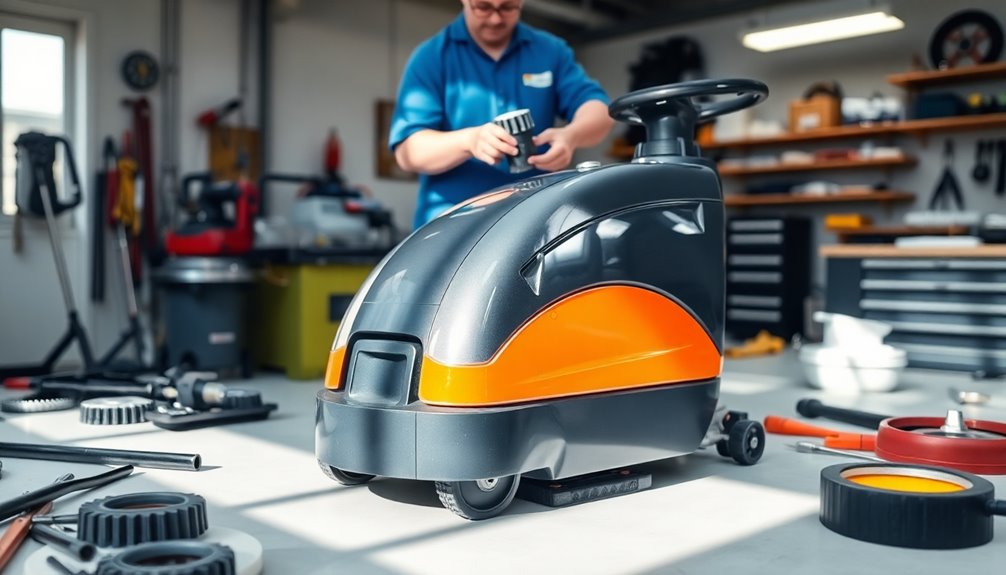
While it might be tempting to overlook routine checks on your floor scrubber, conducting regular machine inspections is crucial for maintaining optimal performance.
These inspections help you catch potential problems early, which can save you from costly repairs and reduce downtime. By ensuring that components like batteries, switches, and controls are functioning correctly, you'll prevent issues such as ineffective water pickup and subpar cleaning results. Regular checks not only extend your machine's lifespan but also enhance its cleaning efficiency. Plus, proper training is essential for executing effective inspections.
Additionally, conducting regular maintenance inspections can help identify potential leaks in the system, further ensuring your floor scrubber operates efficiently. Don't wait for a breakdown; make inspections a part of your routine to keep your floor scrubber operating at its best and to maintain a clean, safe environment.
Utilizing Advanced Maintenance Tools
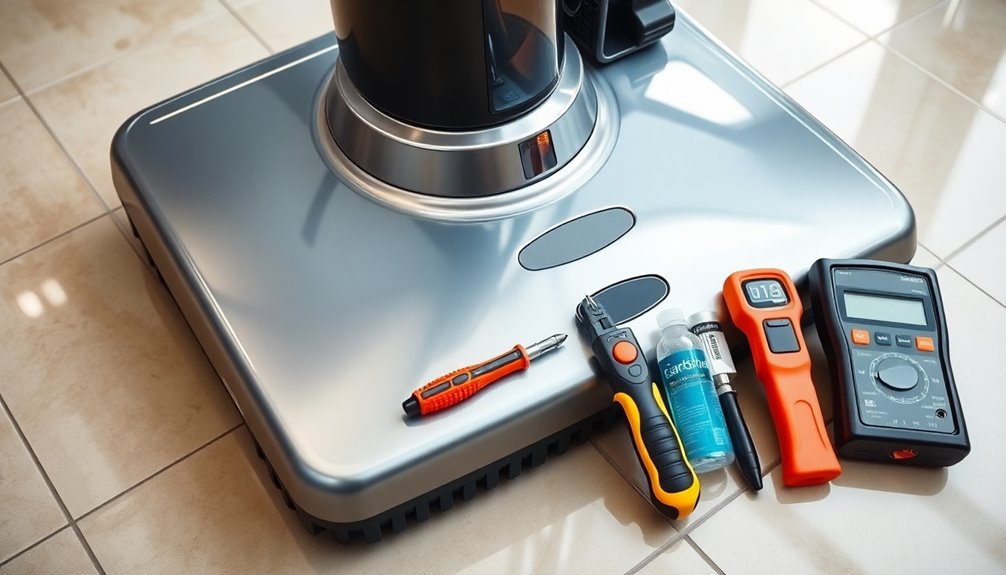
As you strive to keep your floor scrubber in peak condition, utilizing advanced maintenance tools can significantly enhance your efficiency and decision-making.
Software solutions like ToolSense allow you to track equipment usage, schedule maintenance, and monitor battery performance seamlessly. By leveraging real-time data, you can refine your maintenance strategies and make informed decisions regarding your scrubber's health. Additionally, investing in high-quality replacement parts, such as the Advance® 20 Pad Driver, ensures that your equipment operates at its best.
Automating maintenance scheduling minimizes downtime, ensuring your equipment performs optimally when you need it. Additionally, comprehensive reporting features provide insights into equipment status, helping you identify potential issues early.
Streamlining your maintenance processes through these advanced tools not only enhances overall efficiency but also prolongs the life of your scrubber, making your cleaning operations smoother and more effective.
Storing Chemicals Safely
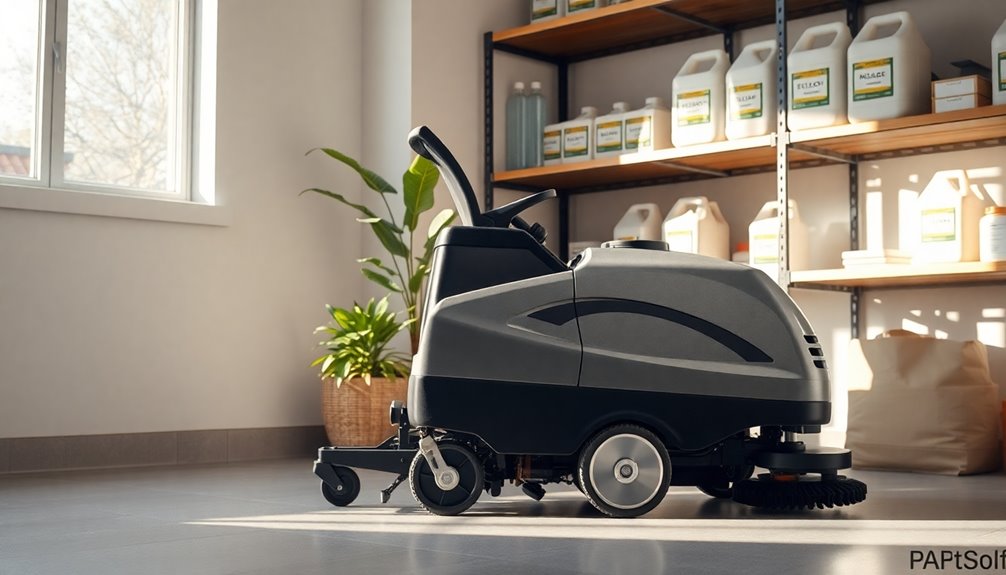
To ensure the safety and effectiveness of your cleaning operations, it's crucial to store chemicals properly.
Choose a secure location away from heat, direct sunlight, and water to prevent degradation or accidents. Make sure the area is well-ventilated to avoid harmful fumes. Additionally, ensure that your storage practices align with hygienic zoning policies to minimize the risk of cross-contamination.
Implement access control by locking storage spaces when not in use, and use clear signage and labeling to identify chemicals and provide safety instructions.
Always store incompatible chemicals separately to prevent dangerous reactions. Equip your storage area with spill containment gear and maintain effective ventilation systems.
Lastly, keep an updated inventory of chemicals, ensuring compliance with safety regulations. Following these guidelines helps you manage chemicals safely and efficiently.
Staff Training for Optimal Operation

Effective staff training is essential for ensuring your floor scrubber operates at peak efficiency and safety. Start by organizing comprehensive training sessions that cover machine functions, safety protocols, and operational procedures. Incorporate hands-on practice, allowing your team to get comfortable with controls and tasks. Don't forget to develop training materials like manuals and videos for quick reference. Emphasize safety guidelines and encourage questions to foster a supportive learning environment. Regular maintenance training should also be included to ensure that staff can perform essential upkeep tasks on the machines.
Tailor the curriculum to your company's specific needs and consider online courses for broader knowledge. Teach staff maintenance processes and how to recognize common issues. Lastly, utilize software for tracking equipment usage and maintenance schedules to enhance efficiency and informed decision-making.
Frequently Asked Questions
How Often Should I Replace My Floor Scrubber Pads?
You should replace your floor scrubber pads every 1-2 weeks, depending on how often you use them and the type of floor you're cleaning.
Keep an eye on the pad thickness; if it's lost about 50% of its original thickness, it's time for a change.
Also, if you notice the pads aren't cleaning effectively and require more passes, that's another sign they need replacing.
Regular checks will help you maintain optimal performance.
Can I Use Homemade Cleaning Solutions in My Floor Scrubber?
Imagine using a homemade vinegar solution in your floor scrubber, thinking it's a great natural cleaner.
However, it mightn't be compatible with your scrubber's plastic parts, causing potential damage.
While homemade solutions can be less toxic, they often lack the cleaning power of commercial products and may leave residues.
Always check your scrubber's user manual to ensure the safety and effectiveness of any cleaning solution you choose to use.
What Signs Indicate It's Time for Professional Maintenance?
When you notice signs like cleaning solution pooling under your scrubber or it running out too quickly, it's time to consider professional maintenance.
If you're experiencing increased cleaning times, reduced efficiency, or visible damage like worn brushes or cracks in hoses, those are red flags.
Also, listen for unusual noises and check for operational issues, such as the scrubber failing to turn on.
Don't ignore these signs—they could save you from costly repairs later.
How Do I Dispose of Used Cleaning Chemicals Safely?
Disposing of used cleaning chemicals safely is crucial, and it's a common misconception that any waste can just go in the trash.
Start by reading the disposal instructions on product labels. If they're unclear, check the Material Safety Data Sheets (MSDS) for guidance.
Always wear protective gear, and never mix chemicals.
For proper disposal, use local hazardous waste collection services or community resources to ensure you comply with regulations and protect the environment.
Is It Safe to Operate the Scrubber on Wet Floors?
Yes, it's generally safe to operate the scrubber on wet floors, but you need to take precautions.
Wear non-slip shoes and use warning signs to alert others. Control your speed to minimize risks, and make sure the area is clear of obstacles.
Always wear personal protective equipment like gloves and goggles to keep yourself safe.
Regularly check your scrubber for any issues that could arise from working on wet surfaces.
Conclusion
By treating your floor scrubber like a prized instrument, you'll keep it humming smoothly, just like a well-tuned orchestra. Regular maintenance is the conductor that ensures each part plays its role to perfection. With the right care, your equipment can shine like polished marble, extending its lifespan and performance. Embrace these tips as your guiding notes, and you'll create an efficient, harmonious cleaning routine that resonates throughout your space, leaving it spotless and inviting.



